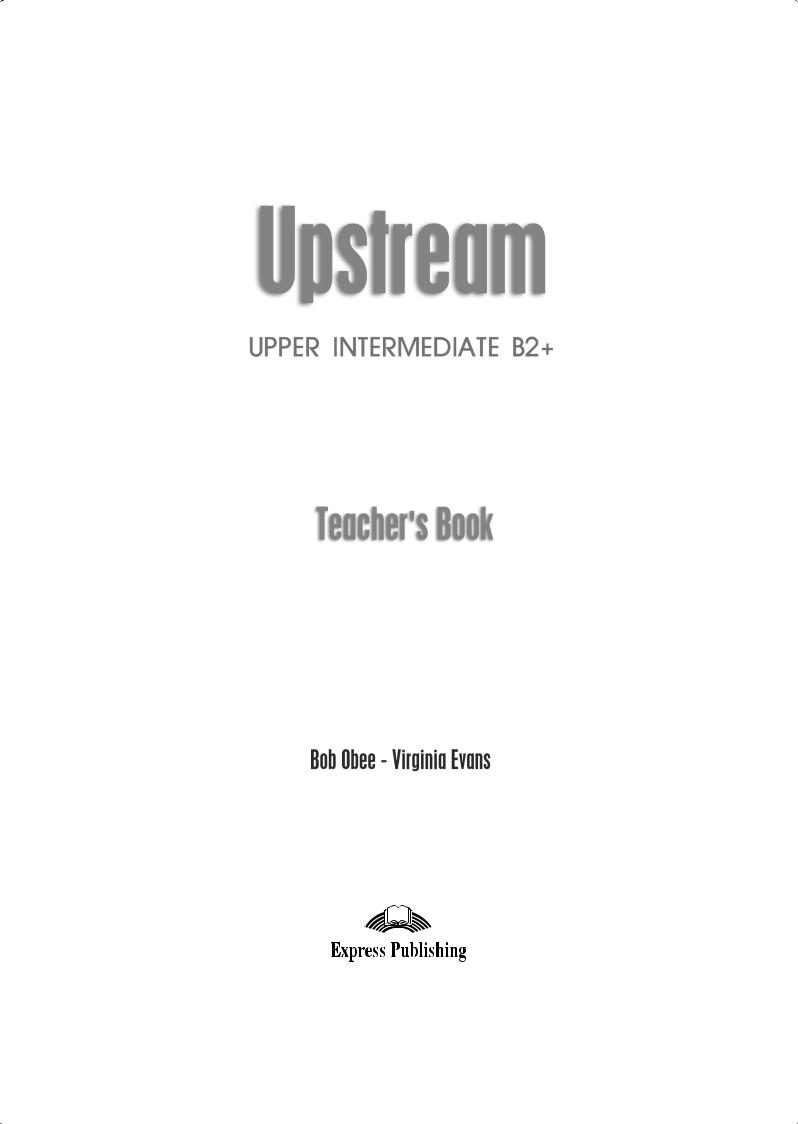
Upstream_B2+_Teacher's Book_2nd Year
.pdf
UPPER INTERMEDIATE B2+
Bob Obee - Virginia Evans


Published by Express Publishing
Liberty House, Greenham Business Park, Newbury, Berkshire RG19 6HW
Tel.: (0044) 1635 817 363
Fax: (0044) 1635 817 463
e-mail: inquiries@expresspublishing.co.uk http: //www.expresspublishing.co.uk
© Bob Obee – Virginia Evans 2003
Design and Illustration © Express Publishing, 2003
First published 2003
Seventh impression 20 __ __
Made in EU
All rights reserved. No part of this publication may be reproduced, stored in a retrieval system, or transmitted in any form, or by any means, electronic, photocopying, or otherwise, without the prior written permission of the publishers.
This book is not meant to be changed in any way.
ISBN 978-1-84325-531-4

C o n t e n t s
UNIT 1 |
Crossing Barriers ................................................................................................................ |
p. |
5 |
UNIT 2 |
Moods and Feelings .......................................................................................................... |
p. |
17 |
Self-Assessment Module 1 ....................................................................................................................... |
p. |
28 |
|
UNIT 3 |
Making a Living ................................................................................................................. |
p. |
29 |
UNIT 4 |
Make Yourself at Home .................................................................................................... |
p. |
42 |
Self-Assessment Module 2 ....................................................................................................................... |
p. |
56 |
|
UNIT 5 |
Modern Living ................................................................................................................... |
p. |
57 |
UNIT 6 |
Going Places ...................................................................................................................... |
p. |
68 |
Self-Assessment Module 3 ....................................................................................................................... |
p. |
79 |
|
UNIT 7 |
History ............................................................................................................................... |
p. |
80 |
UNIT 8 |
Learning Lessons ............................................................................................................... |
p. |
92 |
Self-Assessment Module 4 ....................................................................................................................... |
p. 104 |
||
UNIT 9 |
Planet Issues ...................................................................................................................... |
p. 106 |
|
UNIT 10 |
The Cycle of Life ................................................................................................................ |
p. 116 |
|
Self-Assessment Module 5 ....................................................................................................................... |
p. 128 |
||
Further Practice ...................................................................................................................................... |
p. 130 |
||
Checklist |
...................................................................................................................................... |
p. 133 |
|
Peer Assessment Checklist ....................................................................................................................... |
p. 144 |
||
Key to Workbook ..................................................................................................................................... |
p. 145 |
||
3


Unit1
Unit 1 – Crossing Barriers
Objectives
Vocabulary: English in the world; the Internet; means of communication; aspects of language; speak/say/tell/talk; touch/hold/contact
Reading: multiple matching (reading for main points); multiple choice (reading for detail)
Listening: multiple choice; note-taking (listening for gist, main points, detail, function, location, roles & relationships, attitude, intention, feeling, opinion, specific information)
Speaking: making suggestions; responding positively/negatively; comparing and contrasting; making assumptions; expressing preference; saying goodbye
Use of English: ‘key’ word transformations; open cloze; error correction; word formation: forming abstract nouns Grammar: articles and determiners; partitives; countable and uncountable nouns
Phrasal verbs: switch; put; hang; run; get; call; cut (related to communication)
Writing: letters (formal/semi-formal/informal style)
Lead-in (p. 7)
Read out the title. Discuss the meaning. First, elicit the general meaning of ‘barrier’. A barrier stops something from happening e.g. an object, like a fence or a wall, or a law or a problem. It could also be a language e.g. ‘a language barrier’ – people who don’t speak the same language may not be able to communicate.
1Ask Ss if they have any experience of the highlighted places on the map (if they’ve been there, if they know anyone who lives there etc) and what they know about them. Then ask them what they think the highlighted regions have in common.
Suggested Answer Key
Ithinkthecommonelementisthatinallofthehighlightedregions the English language is important: in some places it is a native language (e.g. Britain, Ireland, North America, Australia and New Zealand); in some places it is an official language (e.g. Papua New Guinea, Hong Kong) although different local languages exist too; in other places it is used widely as the language of administration and business (e.g. Singapore, India), and in some places it is simply an important second language that most people learn (e.g. South America). Some of the regions include former British colonies (e.g. many African states, India, Hong Kong, parts of the Caribbean etc) and so have been influenced by the English language and culture. The native cultures and religions in the highlighted areas vary widely. English can be seen as a way of crossing the barriers createdbydifferentcultures,religionsandnativelanguages.
2a. Explain the task and let Ss look through the sentences and guess what the missing words/phrases could be. Play the recording. Ss do the exercise. Check Ss’ answers.
Answer Key |
|
|
|
1 |
websites |
4 |
celebrities |
2 |
peacetalks |
5 |
productsandservices |
3holidaymakers
b. Go through the list. Ss do the exercise.
Answer Key |
|
|
ñ |
Themedia |
4 |
ñ |
Internationaltrade |
5 |
ñ |
Worldpolitics |
2 |
ñ |
Tourism |
3 |
ñ |
TheInternet |
1 |
Elicit other factors from Ss, then list their ideas on the board.
Suggested Answer Key
Other factors which have encouraged the use of English around the world: Ss wanting to come to an English-speaking country to study; jobprospectsintheirowncountry.
3a. Go through the list. Allow Ss two minutes to do the exercise. Then Ss compare their list to their partner’s.
b.Ask Ss what they find difficult while learning English (e.g. pronunciation, phrasal verbs, grammar, idioms etc). Write them on the board. Go through the table, then get two Ss to read out the example. Ss work in closed pairs. Check round the class then ask some groups to act out their dialogues.
Suggested Answer Key
A:I’vegotaproblemwithpronunciation.
B:IfIwereyou,I’dwatchfilms.
A: That’sagoodidea.
4Tell Ss to look at the two quotations and explain what they mean. Ss in pairs discuss which one they agree with. Encourage Ss to explain why.
Suggested Answer Key
The first one means that if people all over the world spoke one language, communication would be easier and so the world wouldbemorepeaceful.
The second one means that every single one of the world’s languages is very important, so when a language disappears becausenobodyspeaksitanymore,somethingimportantislost.
I agree with the second one, because the first one gives the impressionthatitwouldbeagoodideaifeveryonespokethesame language.
5Ss discuss in closed pairs. Check pairs round the class.
Suggested Answer Key
A:I think that English will be more widely spoken in the future. More and more young people still want to learn English, and manywanttogoandstudyinanEnglish-speakingcountry.
B:That’s true. In many countries, English is still the key to a successful career. I think that English will continue to be the languageofcomputersandtheInternet.
Reading (pp. 8-9)
1a. Write ‘the Internet’ on the board. Ask the class the questions. Find out how many Ss look up websites in English, and how many look up websites in their native language. Write the figures on the board. Ask for comments on the results, e.g. Why do you think so many of youpreferwebsitesin...?
5

Unit1
b.Go through the statements and elicit Ss’ guesses. Ss scan paragraphs 3 and 4 of the text to check if their guesses were correct.
c.Ask Ss to look at the title of the article and the headings in the box. Explain any unknown vocabulary items. Elicit Ss’ ideas about the contents of the article.
Answer Key
1 True |
2 True |
3 True |
4 False |
2Explain that Ss will have to match the headings to the paragraphs. Draw Ss’ attention to the strategy box. Remind Ss that it is not necessary to understand every word in the text to do this exercise.
Ask Ss to skim the whole text for general meaning. Emphasise the importance of getting an overall idea of what the text is about before attempting the paragraphheading matching exercise. (Check general comprehension by asking ‘What change is it about?’ and ‘Is it an easy change to make?’ It is about the change from mainly English websites to websites in many different languages. Translating the sitesintodifferentlanguageswillbedifficultandalotofwork.)
Tell Ss to read the first headed paragraph of the text carefully. Ask Ss to work out why heading B has been chosen for this paragraph. (The phrases ‘it might make you think everyone in the world speaks English’ and ‘give you the impression that it is the world’s most widely spoken language’ and ‘If this were true, it would ...’ all fit the idea of ‘false impressions’ in heading B. Also the figures in the following paragraph show that theimpressionthateveryonespeaksinEnglishisindeedfalse.)
Tell Ss to read the second headed paragraph carefully and choose a heading for it from the list. If Ss find this difficult, draw their attention to all the figures that are mentioned
(‘Yet English is mother tongue for only 5.4% of the world’s population’,‘afurther7%...areproficient’,‘onlyaround12%...can communicatewellinEnglish’,‘Thisfigureisnowherenearthetotal number of people speaking Chinese’) and point out also how this information contrasts with the impression that ‘everyone in the world speaks English’ in the previous paragraph (and is therefore surprising). If Ss easily found the answer (F) without help, ask them to explain which phrases helped them. Continue in the same way for the next paragraph – ask Ss to read and choose a heading, and then ask them to justify their choice. If students are unsure, draw their attention to the phrase ‘people would apparently rather buy things online if they can order in their own language’, pointing out that ‘would rather’ means ‘prefer’ (so H ‘Personal preferences’ is the best heading). Repeat the procedure for the next paragraph. For the last four paragraphs, ask students to continue by themselves, underlining phrases that link to the headings they choose. Then ask Ss to compare their answers and the phrases they have underlined in pairs. Finally check Ss’ answers and the underlined phrases as a class.
Answer Key
1F ‘Yet English is mother tongue for only 5.4% of the world’s population’, ‘ a further 7% ... are proficient’, ‘only around 12% ... can communicate well in English’, ‘This figure is nowhere near the total number of people speaking Chinese’
2H ‘people would apparently rather buy things online if they canorderintheirownlanguage’
3D ‘companies wanting to reach world markets are
beginning to realise that they will have to translate their websitesfortheirvariouscustomers’
4C ‘creating a multilingual website is not an easy task’, ‘Companies wishing to translate their sites ... face both
technical and linguistic problems’, ‘unable to use automatedtranslationsystems’,‘thishugechallenge’
5E ‘Customers ... will need to discuss matters in their own language ... while prices will need to be in the local currency’, ‘Companies will need to adapt their advertising
materials so as not to offend different cultures’, ‘have to change their way of doing business to suit certain customers–inJapan,forexample...’
6G ‘Such vast changes will not happen overnight’,
‘Companies...needtimetotranslatetheirsites...’
7A ‘local companies ... will certainly be at an advantage’, ‘offermoreopportunitiestosmallerbusinesses’
3Ask Ss to do the exercise in pairs. Encourage them to try and guess the meaning of the words from the context. Check Ss’ answers.
Suggested Answer Key
benefits: advantages fields: areas proficient: excellent accessing: using
local currency: moneyusedineachcountry format: arrangementofinformation adapt: changeslightly
guaranteed: certain pace: speed
local companies: businesses that operate only in the country wheretheyarebased
expanding: growing
4Point out to Ss that these are all pairs of words that were used in the text they have read. Ask Ss to find them in the text, then elicit/explain their meanings. Ask Ss to work in pairs to write short sentences using the items.
Answer Key |
|
mothertongue |
accesstheInternet |
culturaldiversity |
targetmarket |
fastpace |
conductbusiness |
Suggested Answer Key
MymothertongueisPolish.
Immigrantsbringculturaldiversityto acountry. Thefastpaceofcitylifeisexhausting.
Soon we will be able to access the Internet from our mobile phones.
Teenagersareanimportant targetmarketformobilephones. ManycompaniesconductbusinessontheInternet.
5Show Ss how to work out the meaning of the first two items from the context surrounding the lines given. Remind Ss that working out meaning from context is a very important reading skill, and will help them read texts more successfully. Then ask Ss to work in pairs to work out items 3 to 6. Check Ss’ answers.
Answer Key |
|
|
|
|
|
1 |
b |
3 |
a |
5 |
b |
2 |
b |
4 |
a |
6 |
b |
6

Unit1
6Ask Ss to look again at the text and underline the reasons. Then ask Ss to discuss other reasons in pairs.
Suggested Answer Key Reasons in text:
ñ‘only around 12% of the world’s population can communicate wellinEnglish’(lines21-22)
ñ‘people would apparently rather buy things online if they can orderintheirownlanguage’(lines31-32)
ñ‘by 2003 only one third of Internet users will be speakers of English’(lines33-34)
ñ‘companies wanting to reach world markets are beginning to realise that they will have to translate their websites for their variouscustomers’(lines34-37)
Other possible reasons:
ñavoiddominationofonelanguageandculture
ñyoung children can get information from the Internet if it’s in theirownlanguage
7Ss discuss the questions in pairs. Ask some pairs to report back to the class.
Suggested Answer Key
ñA: I would really enjoy using a multilingual Internet because then I could look up websites in English and in my mother tongue.Whataboutyou?
B:Well,IthinkithelpsmyEnglishtouseEnglishwebsites,but it would be relaxing and enjoyable to use my own languageaswell.
ñA: I think that if everyone can use their own language on the Internet, there’s a risk that people will become isolated: they will stay in their own language groups and won’t communicate with people with other languages and cultures.Whatdoyouthink?
B:Iagree.TheWorld-WideWebwon’tbeworldwideanymore. When there is a common language, like English, everyone cancommunicatewitheveryoneelse.
Language Focus (pp. 10-11)
1a. Explain to Ss what a collocation is and how important it is: when two or more words go together naturally without a necessarily logical reason. Verbs can collocate with nouns, e.g. ‘do business’, adjectives can collocate with nouns, e.g.‘heavytraffic’, adverbs can collocate with verbs and/or adjectives, e.g. ‘seriously injured’, etc. Tell Ss that they are going to think about collocations connected with different ways of communication. Ss do the exercise in pairs. Check Ss’ answers.
Answer Key
ñletters: write letters; receive letters; send letters; answer letters; addressletters
ñphone call: answer a phone call; receive a phone call (Also makeaphonecall)
ñfax: sendafax;receiveafax;answerafax
ñtext message: send a text message; receive a text message; writeatextmessage;answeratextmessage
ñnote: writeanote;sendanote;receiveanote;answeranote
ñface to face: communicatefacetoface;talkfacetoface
ñemail: write an email; send an email; receive an email; answer anemail
b.Choose two Ss to read the example aloud. Then Ss do the exercise in pairs.
Suggested Answer Key
ñA: I usually make a phone call to book a table at a restaurant.
B:Me,too.
ñA: I usually talk face to face to introduce somebody to somebodyelse.
B:Me,too.
ñA: Iusuallywritealettertomakeanofficialcomplaint.
B:Me,too,butpeoplecanalsocomplainbyphoneorfaceto face.
ñA: I usually make a phone call or send an email to ask a favour.
B:Me, too, but people can also write a note or ask a favour facetoface.
ñA: I usually make a phone call or send a text message to invitesomeonetoaparty.
B:Me, too, but people can also invite someone to a party by letter.
ñA: Iusuallytalkfacetofacetogetsomeone’sattention.
B:Me, too, but people can also get someone’s attention throughaphonecalloranemail.
ñA: I usually send a fax or make a phone call to set up a meeting.
B:Me, too, but people can also set up a meeting by letter or email.
c.Do this as a brainstorming exercise with the whole class.
Suggested Answer Key
telegram; video conferencing; graffiti; sign language; gestures; facialexpressions
d.Ss work in pairs. Ask Ss to discuss which means of communication (from Ex. 1a) could be described by each adjective.
Suggested Answer Key
ñI think writing letters is sometimes complicated because you havetoexpressyourselfcarefully.
ñI think making a phone call is costly because you have to pay perminute.
ñI think making a phone call is reliable because telephones rarelybreakdown.
ñI think sending a text message is economical because each messagecostsmuchlessthanaphonecall.
ñI think writing a note is unreliable because the note might get lost.
ñI think talking face to face is personal because you can see the personyouaretalkingto.
ñI think sending an email is efficient because it arrives much fasterthanaletter.
ñI think writing a letter or sending a fax is impersonal because youcannotseetheperson.
ñI think writing a letter or sending an email can be inefficient becausethepersonmightnotchecktheirmailstraightaway.
ñI think writing a letter or sending a fax is formal because we usuallywriteinfullsentencesandincludeaddresses.
ñI think writing a note or sending an email is informal because weusuallywriteinnoteform.
ñI think talking face to face with someone is easy because we canusuallycommunicatequickly.
2a. Explain the meaning of the verbs. Then, Ss work in pairs, and match the pictures to the verbs.
7

Unit1
Answer Key |
|
|
|
|
|
|
1 |
E |
3 |
G |
5 |
C |
7 F |
2 |
B |
4 |
D |
6 |
A |
|
b.Explain that as Ss cannot be sure exactly what each situation is, they need to use the language in the box to show that they are guessing. Ss do the exercise in pairs.
Suggested Answer Key
AJudging from their happy faces, the people might be clapping theirhandsbecausetheyareenjoyingaperformance.
B Shecouldbeweepingbecauseshe’shadbadmarksatschool.
CShemustbeyawningbecauseshe’stired.
D Hemaybegigglingbecauseshe’stoldhimajoke.
E Shemustbeyellingbecauseshe’sveryupsetaboutsomething.
F Ican’tbecertain,butitlooksasifhe’sblowingatoywhistle.
G Hemustbewhisperingasecretinherear.
3 a. Explain to Ss that this exercise also deals with collocations, this time connected with the topic of language. Ss do the exercise in pairs. Elicit/Explain the meaning of each collocation when checking answers.
Answer Key |
|
|
|
|
|
|
|
1 |
body |
3 |
native |
5 |
language |
7 |
talk |
2 |
first |
4 |
accent |
6 |
tongue |
8 |
speech |
b.Ss do the exercise in pairs. Check Ss’ answers.
(Ss’ownanswers)
4Explain to Ss that they are going to think about gestures and what they mean. Ask Ss to define what gestures are and why people make gestures: a gesture is a movement of part of the body, usually involving hands and arms; people make gestures to express emotion, convey information, etc. A gesture is non-verbal, though it sometimes accompanies words. Ask Ss to give examples of gestures from their country.
a. Ss do the exercise in pairs.
Answer Key |
|
|
|
|
2 e |
3 b |
4 c |
5 f |
6 d |
b. Elicit answers from different students. |
|
|||
Answer Key |
|
|
|
|
impatient:1 |
disappointed:3 |
|
calm:5 |
|
pleased:2 |
|
uncertain:4,6 |
|
|
Suggested Answer Key (SscanuselanguagefromEx.2b)
The people in picture 2 seem to be pleased because they are happy tomeeteachother.
The man in picture 3 seems to be disappointed because he may havereceivedsomebadnews.
The man in picture 4 seems to be uncertain because he is thinking aboutaproblem/situation.
The man in picture 5 seems to be calm because he is reassuring his employee/colleague.
The man in picture 6 seems to be uncertain because he doesn’t knowtheanswertoaquestion.
As an extension, Ss in pairs try to think of other situations where the sentences a to f can be used.
5Write say, tell, talk and speak on the board. Point out that collocations can often help them decide which word to use. Elicit collocations Ss know with these verbs and write them on the board under the right verb, e.g. to tell the time, to say you’re sorry, etc. Tell Ss that it is important to record whole collocations in their vocabulary notes, not just individual words. Ss do the exercise in pairs.
Answer Key |
|
|
|
1 |
totellthedifference |
4 |
talksnon-stop |
2 |
speakyourmind |
5 |
tellingpeoplewhattodo |
3 |
don’tsayaword |
6 |
talkbusiness |
Sentence4matchesthepicture.(‘Achatterbox’)
6Elicit the meaning of ‘idioms’ and ‘fixed phrases’: groups of words without a necessarily transparent meaning. Ss may know the meaning of individual words, but not the overall meaning when they are put together in a particular way. For example, to burn the candle at both ends. Ask Ss for other examples. Ss do the exercise in pairs. Check Ss’ answers.
Answer Key |
|
|
|
2 |
getholdof |
5 |
holdtheline |
3 |
losetouchwith |
6 |
comeintocontactwith |
4lostcontactwith
As an extension, remind Ss of other useful fixed phrases using these words, e.g. get in touch with, keep in touch. Alternatively, ask Ss to choose an idiom and draw a picture based on that. Ss show their pictures to the class. The class must understand the idiom.
7a. Ss should work in pairs. Tell them to do as many as they can on their own, then to check a dictionary for the rest. Ss should memorise these phrases.
Answer Key |
|
|
|
|
|
|
|
3 |
at |
7 |
to |
11 |
at |
14 |
with |
4 |
with |
8 |
at/to |
12 |
with |
15 |
with |
5 |
at |
9 |
to |
13 |
with |
|
|
6 |
at |
10 |
to |
|
|
|
|
b. Ss can either continue with this story or invent one themselves, using all the verbs and prepositions in Ex. 7a.
Suggested Answer Key
S3: Ichatted to her forafewminutes.
S4: ThenIsawsomeonewaving at me fromacrosstheroad. S5: Ismiled at him butcouldn’tthinkwhohewas.
S6: Hecameoverandshook hands with me. etc
8Remind Ss of the importance of phrasal verbs. Advise them to learn them in context rather than lists. Ask Ss whether they are more likely to find phrasal verbs (multi-word verbs) in speech or writing (in speech). Tell Ss that there is usually a formal single verb equivalent. Give an example: Putupwith= tolerate. Ask Ss to give examples of phrasal verbs they already know using the verbs given. Write them on the board.
Ss do the exercise individually. Check Ss’ answers and the meaning of each phrasal verb.
8

Unit1
Answer Key |
|
|
|
|
|
|
|
1 |
switched |
3 |
hanging |
5 |
cut |
7 |
call |
2 |
put |
4 |
ran |
6 |
get |
8 |
hung |
For further practice, Ss (in pairs or for homework) make up a dialogue using as many of the phrasal verbs from this exercise as possible.
Listening & Speaking (pp. 12-13)
1a. Tell Ss they are going to listen to eight people talking. Draw their attention to the strategy box. Remind them how important it is to read the questions carefully. Emphasise how much information they can get from the questions. Ss then do the exercise in pairs.
Suggested Answer Key
1Key words to be underlined: talking about the organisation sheworksfor;Whatservice...?; theblind
ñoneperson
ñfairlyformallanguageandvocabularyabouttheblind
ñshewilltalkaboutaservicefortheblind
2Key words to be underlined: conversation in an office; Why hasthemangonethere?
ñtwoormorepeople
ñfairlyinformallanguage
ñthereasonwhythemanhasgonetotheoffice
3Key words to be underlined: get connected to the Internet callahelpline;Whatdoyouhavetodo?
ñoneortwopeople
ñfairlyformallanguage
ñinstructionsabouttheInternet
4Key words to be underlined: leavingamessage; answerphone; Whatdoeshewantthepersontodotomorrow?
ñoneperson
ñfairlyinformal
ñarequestabouttomorrow
5Key words to be underlined: radio interview; How does the man...feel?
ñprobablytwopeople
ñfairlyinformal
ñquestionsandanswers,themanwillexpressfeelings
6Key words to be underlined: news programme; What is the reportabout?; new
ñprobablyoneperson
ñfairlyformal
ñsomethingnewabout means ofcommunication,perhaps mobilephones
7Key words to be underlined: couple talking in a cafe; How doesthemanfeelaboutwhatthewomanisshowinghim?
ñtwopeople
ñinformal
ñthewomanwilltalkaboutsomethingsheshowstheman, hewillexpressanopinionaboutit
8Key words to be underlined: talking to a group of people; the man’spurpose?; aproduct
ñprobablyone
ñfairlyformal
ñthe man will say something about a product, and will try toaffectthegroup’sopinion
b.Ss listen to each speaker/conversation twice. Stop the recording after the second playing of each one to check the answer. Also elicit evidence for the answers by asking Ss to recall what they heard that helped them to choose the right answer. If necessary play each section again to check the evidence, or ask Ss to look at the tapescript at the back of their books.
Answer Key |
|
|
|
|
|
|
|
1 |
C |
3 |
A |
5 |
B |
7 |
C |
2 |
A |
4 |
A |
6 |
C |
8 |
B |
Evidence for answers:
1Brailleliteracy;...noblindpersonshouldbelimitedinchoosing
what she would like to read; ... access to whatever Braille publicationtheyneed
2 aboutthephones;...we’vehadthisproblem;...Icanseetothat
3If you need help with setting up your Anderson Online Internet connection,pleasepress1
4I’vetakentheFiattothegarageanditshouldbeokaytopickit uptomorrow,socouldyou?
5hesitationandrepetitionthroughout
6The new Wesley model; ... at the touch of just one button, you
are instantly connected to another mobile; ... and you can leaveashortvoicemessage
7And how much would that be?; Probably about a hundred
quid;Forgetit.
8The aerial about to be installed has been inspected and approved by scientists; copies of the certificate of safety are available; ... the aerial has been manufactured in compliance withtheguidelinesissuedbythegovernment
2a. Tell Ss that they are going to hear a report about public phone boxes in the UK, and about how people are using them less.
1Ask the whole class these questions.
2,3 Deal with questions 2 and 3 together as a class. Draw Ss’ attention to the strategy box. Go through the incomplete sentences in Ex. 2b, explaining unknown vocabulary items, helping Ss to paraphrase the sentences (e.g. 1 BT profits from public phones have fallen) and eliciting what type of information is missing.
Suggested Answer Key
1adverb – describing how much the money has decreased, e.g. dramatically, a lot, etc, or a period of time, e.g. in the last 5
years
2 Aperiodoftime,e.g.6months,2years,etc.(number) 3 noun–maybesomewordlike‘box’?
4number–eitherayearoraplace
5 adjective–possiblydescribingthecolourofkiosks
6 noun–society?wayoflife?
7noun–nameofcolour
8 pastparticiple–increased?doubled?
9 numberoradjective–public?new?
10number–anamountofmoney
b.Play the recording twice, while Ss listen and write their answers. Check Ss’ answers as a class, if necessary replaying relevant sections of the recording until Ss find the correct answers.
9
